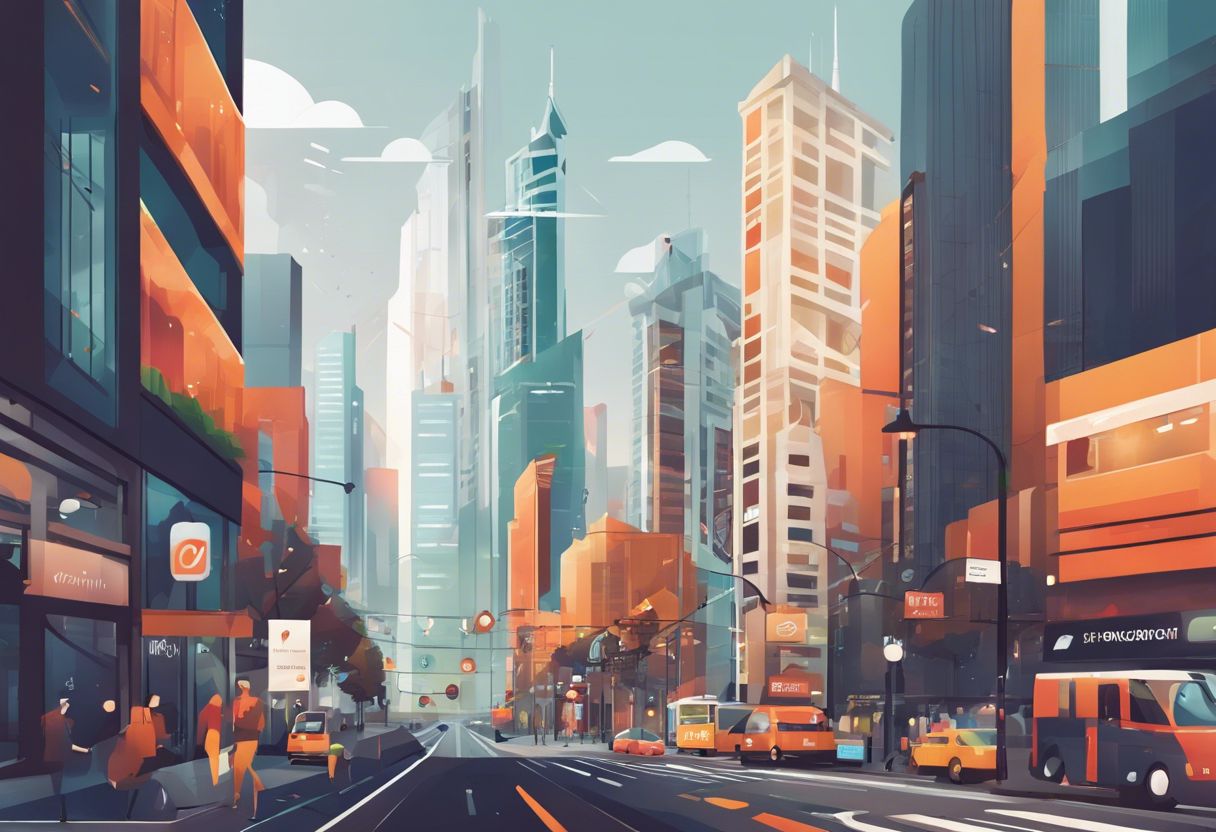Innovative Navigation: Redefining User Journeys On Your Site

Welcome to the world of innovative navigation. This is about changing how people move through your website. Imagine a map that not only shows where things are but also knows where you want to go and helps you get there.
User journeys on websites are paths people take from when they arrive until they leave. Making these journeys smooth is really important because it makes visitors happy, and happy visitors come back or buy what you’re selling.
Nowadays, we can learn a lot about how people use our sites because of customer data. We use tools like Adobe Customer Journey Analytics to understand better and improve these user journeys while keeping privacy in mind.
Personalization plays a big part too. It means giving each visitor a special experience just for them, which can make them more excited about using your site.
To do this well, we need to create maps called customer journey maps. These help us see every step a person takes on our site so we can make their experience even better.
Cool new tech like AI and chatbots are making things even more exciting by talking with users as if they were human helpers!
We also know pictures need to load fast for everything to run smoothly, so optimizing images is super important.
Some challenges come with all these changes though. For example, making sure everyone feels in control even when personalizing their path or helping those who might not have the best access to technology still enjoy their visit as much as anyone else does.
Lastly, if we keep testing different ideas and listening to what users say, we’ll always be getting better at guiding them through our sites in awesome new ways.
Get ready — let’s explore how innovative navigation will change future user journies!
Understanding User Journeys on Your Site

Understanding the intricacies of user journeys on your site is crucial for creating a seamless and enjoyable experience for visitors. By identifying key touchpoints and pathways, you can optimize navigation to enhance user engagement and satisfaction.
What is a User Journey?

A user journey is the path a person takes to reach their goal on our site. It’s like a map of steps they follow, from the first click to the final action, such as buying something or getting help.
Through this journey, we see everything through their eyes. This helps us make their experience better.
We use a user journey map to show the process visually. With this map, we can see where users go and what they do on our site. We pay attention to things that are easy for them and fix parts that might be hard or confusing.
The smoother this path is, the happier people feel using our site, and they might come back more often.
Seeing how users interact with our site shows us what works well and what doesn’t. We aim to make each step clear and easy so people can find what they need without any trouble. Our job is to guide them right where they want to go in a way that feels good for them.
The Importance of Smooth User Navigation

After we’ve looked into what user journeys are, let’s dive into why smooth navigation is so important. Good website navigation works like a map. It guides visitors through your site and helps them find what they need quickly.
If people can move around easily on your site, they’re more likely to stick around, buy things, or come back later.
We understand that human brains don’t have unlimited power to process information. That’s why making navigation simple and clear is key. We aim for users to navigate our sites with ease without getting lost or frustrated.
This means our menus should say exactly where they lead and not use confusing names or too much tech talk.
Great navigation design makes sure customers have an easy time from start to finish. They feel in control and know where to click next without guessing. When we get this right, customers often enjoy using the site more, which can mean better sales for businesses like ours.
The Impact of Customer Data on User Experience

Leveraging advanced analytics and customer data can provide valuable insights into user behavior, preferences, and pain points, allowing for the creation of more personalized and tailored navigation experiences.
However, it’s important to consider privacy considerations in data usage to ensure a balance between personalization and user control.
Leveraging Analytics for Enhanced User Journeys

We see the power of customer data and how it can make user journeys on our website even better. By diving into analytics, we learn what our visitors like and where they might get stuck.
This isn’t just about numbers; it’s about real stories behind those clicks and scrolls. With tools like Adobe Customer Journey Analytics, we track every touchpoint. We find out which paths lead to happy customers and which ones need fixing.
This understanding helps us build a site that feels personal to each visitor. We spot trends using predictive insights, so we know what users might look for next. It’s all about making their experience smoother and more enjoyable – this keeps them coming back for more! Our goal is to set up pathways that not only meet but exceed user expectations by focusing on satisfaction at every step.
Privacy Considerations in Data Usage

When we leverage customer data to enhance user journeys, it’s crucial to prioritize privacy. Respecting users’ information is essential for building trust and safeguarding their personal details.
By considering ethical implications and obtaining consent, businesses can provide personalized experiences while ensuring that user dataremains secure. It’s important to adhere to the 7 Principles of Privacy by Design, integrating privacy into all aspects of product and system designs.
As emerging technologies continue to evolve, maintaining data privacy becomes even more critical. We need to be mindful of how we collect and retain user information, keeping analytical insights in check while addressing potential privacy concerns.
Personalization and Its Role in Navigation

Creating customized pathways for users is essential in enhancing their experience on your site. By utilizing predictive insights, you can tailor the navigation to match each user’s preferences and behavior, ultimately leading to increased engagement and satisfaction.
Creating Customized Pathways for Users

In creating customized pathways for users, we focus on tailoring experiences to suit individual needs and preferences. Here’s how we achieve this:
- Tailored pathways ensure a personalized user experience, meeting individual users’ unique needs and preferences by offering customized navigation.
- Personalization enhances the user journey, leading to hyper – personalized engagement and contextual interactions that cater to the specific requirements of each user.
- Customer care journeys can be personalized by involving customers in the design process and using data across touchpoints, optimizing brand interactions.
- High – tech touchpoints have transformed customer engagement into fully dynamic portals, reshaping the entire customer journey through digital signals emitted by consumers throughout their activities.
Predictive Insights for User Engagement

As we focus on creating customized pathways for users, it’s vital to explore the power of predictive insights in enhancing user engagement. Anticipatory analytics provide invaluable data that can lead to heightened customer loyalty and increased engagement.
By leveraging predictive modeling and tailoring experiences based on customer expectations, businesses have the opportunity to enhance interactive engagement and optimize the online consumer journey.
Understanding user interaction through proactive insights allows for personalized strategies that can significantly impact customer retention.
Customer behavior is greatly influenced by personalized interactions, making omnichannel personalization a key factor in modern business success. It’s important to note that digital signals emitted by consumers throughout their activities play a significant role in understanding and predicting customer experience.
Customer Journey Mapping for Site Navigation

Understanding the key stages in a user’s journey on your site is essential for creating an effective navigation system. By identifying touchpoints and mapping out the pathways users take, you can optimize their experience and guide them towards specific goals or actions on your site.
Key Stages in the User Journey

As business owners, understanding the key stages in the user journey is crucial for optimizing site navigation and enhancing customer satisfaction. Here are the key stages in the user journey:
- Discovery: This stage involves users becoming aware of a product, service, or brand through various touchpoints such as social media, search engines, or advertisements.
- Research: Users actively seek information to address their needs or problems related to the product or service they discovered, often involving comparisons and evaluations.
- Evaluation: At this stage, users consider specific products or services based on their research findings and begin to form preferences.
- Purchase: Users make the decision to buy a product or service after evaluating options and finding the best fit for their needs.
- Experience: After purchasing a product or service, users engage with it and experience its benefits, forming perceptions about its usability and value.
- Support: This stage involves post-purchase interactions where users seek help with using the product, addressing issues, or looking for additional resources.
- Loyalty: Users who have positive experiences may become loyal customers, advocating for the brand and making repeat purchases.
- Advocacy: Satisfied customers share their experiences with others, potentially influencing new users’ discovery and research phases.
Touchpoints and Their Role in Navigation

After understanding the key stages in the user journey, it’s essential to recognize touchpoints and their significant role in navigation. Touchpoints are crucial interactions that occur as customers journey through your site. These interactions, such as browsing a product page or engaging with customer support, form the basis of their overall experience. Here’s a detailed look at how touchpoints contribute to enhancing user journeys:
- Customer touchpoints serve as important moments of interaction throughout the user’s experience on your website.
- They provide valuable insights into customer behavior, preferences, and pain points, allowing you to tailor their journey effectively.
- Understanding and optimizing touchpoints enable you to create personalized experiences that resonate with your users.
- By mapping out all possible touchpoints, you can gain a comprehensive understanding of the customer journey and improve navigation accordingly.
- Leveraging touchpoints empowers you to engage with users across various channels, ensuring a seamless and cohesive experience.
- Each touchpoint represents an opportunity to positively influence the user’s perception of your brand and encourage repeat engagement.
- Analyzing touchpoint data allows you to identify patterns and trends, enabling informed decision – making for navigation enhancements.
- Effectively managing touchpoints ensures that users encounter consistent messaging and branding throughout their journey on your site.
- Personalized experiences across touchpoints can drive customer satisfaction and loyalty while fostering long-term relationships.
Technological Advancements in Site Navigation

Harnessing the power of AI and machine learning, websites can now offer dynamic pathways tailored to each user’s preferences. Additionally, the integration of chatbots and virtual assistants provides real-time support for seamless navigation.
AI and Machine Learning for Dynamic Pathways
Artificial intelligence (AI) and machine learning play a pivotal role in refining user experiences on websites. With AI, we’re able to analyze site layouts and user interaction, allowing us to craft dynamic pathways that optimize the overall user experience.
These technological advancements enable autonomous learning, real-time decision making, and predictive insights for enhanced user engagement. Machine learning processes vast amounts of data from various sources, such as customer behaviors and preferences, which aids in creating customized pathways for users based on their individual needs.
Moreover, AI tools are constantly evolving. They have the potential to assess website designs and layouts comprehensively while providing valuable recommendations for improving user journeys.
The Use of Chatbots and Virtual Assistants
Chatbots and virtual assistants are game-changers in site navigation. Through artificial intelligence, they offer personalized assistance to users, enhancing their experience. These conversational agents leverage machine learning technology and natural language understanding to interact with customers efficiently, providing automated customer service.
Chatbot technology is an essential tool that businesses can utilize for improved and intuitive customer engagement.
By implementing chatbots and virtual assistants on your site, you can create a seamless experience for users by having personal digital assistants available 24/7. They revolutionize time management through quick responses and accessibility.
Additionally, these technological advancements play a significant role in creating more efficient processes within the digital landscape.
This innovative form of customer interaction not only enhances user engagement but also significantly impacts how businesses navigate the future of user journey optimization while setting new industry standards.
Enhancing Performance with Ease: Image Optimization Secrets
 Image optimization is crucial for boosting your website’s performance and reducing costs. By compressing and optimizing photos, you can enhance loading times, leading to improved user experience and increased revenue.
Image optimization is crucial for boosting your website’s performance and reducing costs. By compressing and optimizing photos, you can enhance loading times, leading to improved user experience and increased revenue.
Platforms like imgix offer solutions for efficient visual content optimization, aiding in the enhancement of website performance while also contributing to cost reduction and better return on investment.
Moreover, focusing on media file optimization can significantly impact your site’s overall functionality, ensuring a seamless browsing experience for your users while positively affecting your bottom line.
In addition to enhancing performance, image optimization plays a vital role in improving user engagement and conversion rates on your website. It not only affects load times but also influences how visitors interact with visual content on your site.
Therefore, prioritizing image compression and visual content optimization can lead to substantial improvements in various aspects of site performance as well as financial outcomes.
Overcoming Challenges in Redefining User Journeys

Balancing personalization with user control can be a challenge, but it’s essential to ensure that users feel empowered in their navigation experience. Addressing the digital divide in user experience is another obstacle that requires careful consideration and strategic planning to overcome.
Balancing Personalization with User Control
In our quest to personalize user experiences, we must strike a balance with user control. It’s about crafting customized journeys that cater to individual preferences while empowering users with the freedom to manage their data and privacy settings.
By doing so, we honor their rights and build trust through transparent interactions. This delicate equilibrium is crucial in cultivating loyal customer relationships, especially in the realm of personalized marketing and loyalty programs.
Businesses need to navigate the fine line between customization and user empowerment when designing customer journeys. It’s not just about delivering tailor-made experiences but also ensuring that users feel respected and in control of their interactions.
Addressing the Digital Divide in User Experience
In our quest to redefine user journeys and enhance digital experiences, it’s crucial to address the digital divide in user experience. The digital divide presents challenges related to technology access, gender gap, and educational disparities that can impact customer satisfaction and engagement.
We need to consider the global context of digital inclusion and ensure that technological advancements are accessible to all users, regardless of their backgrounds or circumstances.
Closing the digital divide requires a human approach alongside technological solutions. It involves acknowledging the barriers that exist in accessing and using technology, working towards equitable digital transformation, and fostering inclusivity in web navigation.
Best Practices for Implementing Innovative Navigation

When implementing innovative navigation on your site, it’s crucial to set clear objectives for user navigation, profile user personas and goals, and engage in iterative testing and user feedback loops to ensure a seamless user experience.
These best practices will help you optimize user journeys and enhance overall customer satisfaction with your website.
Setting Clear Objectives for User Navigation
When implementing innovative navigation on your site, setting clear objectives for user navigation is crucial. We need to define specific goals and expectations for how users should navigate through the site.
Customer journey maps should clearly outline the intended outcomes of user interaction with the website, ensuring that every step aligns with broader business objectives.
By profiling different user personas and identifying their unique goals, we can create a more tailored and effective navigation experience. This personalized approach ensures that users find what they are looking for quickly and easily, leading to improved satisfaction and engagement.
Let’s collaborate in defining these clear objectives to achieve an optimized user journey.
Profiling User Personas and Goals
We’ve covered the importance of setting clear objectives for user navigation. Now, let’s talk about profiling user personas and goals as a key aspect of implementing innovative navigation strategies. Here are some essential steps to consider:
- Understand Your Audience: Take the time to gather information about your users, such as their demographics, behavior patterns, and preferences.
- Create User Personas: Develop fictional characters that represent different segments of your target audience based on the collected data. This helps in understanding and empathizing with their needs and motivations.
- Define User Goals: Identify the primary objectives or tasks that your users want to achieve when interacting with your website or platform.
- Align Navigation with User Personas and Goals: Ensure that the pathways and features within your site are tailored to meet the specific needs and expectations of each user persona.
- Utilize Customer Understanding: Use customer data and insights gained from user personas to continuously refine and optimize the navigation experience on your site.
- Incorporate User Information: Integrate relevant details from user personas into the design and functionality of your site to create personalized and intuitive navigation pathways.
- Enhance Customer Experience: By aligning navigation with user personas and goals, you can significantly improve customer satisfaction and overall engagement on your platform.
Iterative Testing and User Feedback Loops
Iterative testing and user feedback loops are crucial for continual improvement in user navigation. Embracing an iterative approach to design, where feedback loops drive refinement, is essential for innovative innovation. Here are some best practices to implement this:
- Prototyping: Continually create and test prototypes to gather insights from users’ interactions with different designs and functionalities.
- User-Centric Design: Prioritize user experiences by refining designs based on continuous feedback and usability testing.
- Agile Development: Utilize an agile framework to facilitate quick iterations, allowing for rapid integration of user feedback into the design process.
- Design Refinement: Regularly refine designs based on customer feedback, ensuring that navigation remains intuitive and efficient.
- Usability Testing: Conduct frequent usability tests to identify pain points or areas for improvement in the user journey.
Conclusion: The Future of User Journey Optimization

So, what’s next for your site’s navigation experience? With innovative technologies and strategic customer data analysis, the future of user journey optimization looks promising. By integrating personalization and embracing technological advancements, businesses can enhance their customers’ digital navigation experiences.
It’s time to take a proactive approach towards redefining user journeys on your site with a focus on seamless interactions and personalized pathways.
By setting clear objectives and continuously iterating based on user feedback, you can ensure that your site offers an engaging and optimized user experience. The potential benefits of implementing innovative navigation strategies are extensive – from improved customer engagementto enhanced website usability.
Embracing these principles will undoubtedly set the stage for success in the fast-paced world of online business.
Discover how to significantly boost your site’s speed and user experience with our expert image optimization secrets.
FAQs
1. What is innovative navigation on a website?
Innovative navigation refers to creative and user-friendly ways to help visitors find information within a website, often using interactive elements or non-traditional menus.
2. How can innovative navigation improve user experience?
Innovative navigation can enhance user experience by making it easier for visitors to navigate through the site, find what they need quickly, and engage with content more effectively.
3. Are there any downsides to implementing innovative navigation on a website?
While innovative navigation can be beneficial, overly complex designs may confuse users. It’s important to balance creativity with usability when implementing new navigational elements.
4. Do I need advanced technical skills to implement innovative navigation techniques?
Implementing basic innovative navigational features such as dropdown menus or scroll-activated animations does not require advanced technical skills. However, more complex features may require web development knowledge or assistance from a professional.
5. Can innovative navigation work for all types of websites?
Yes, while specific approaches may vary depending on the nature of the site (e.g., e-commerce versus informational), incorporating some level of creativity in site navigation can generally benefit most websites’ user experiences.


